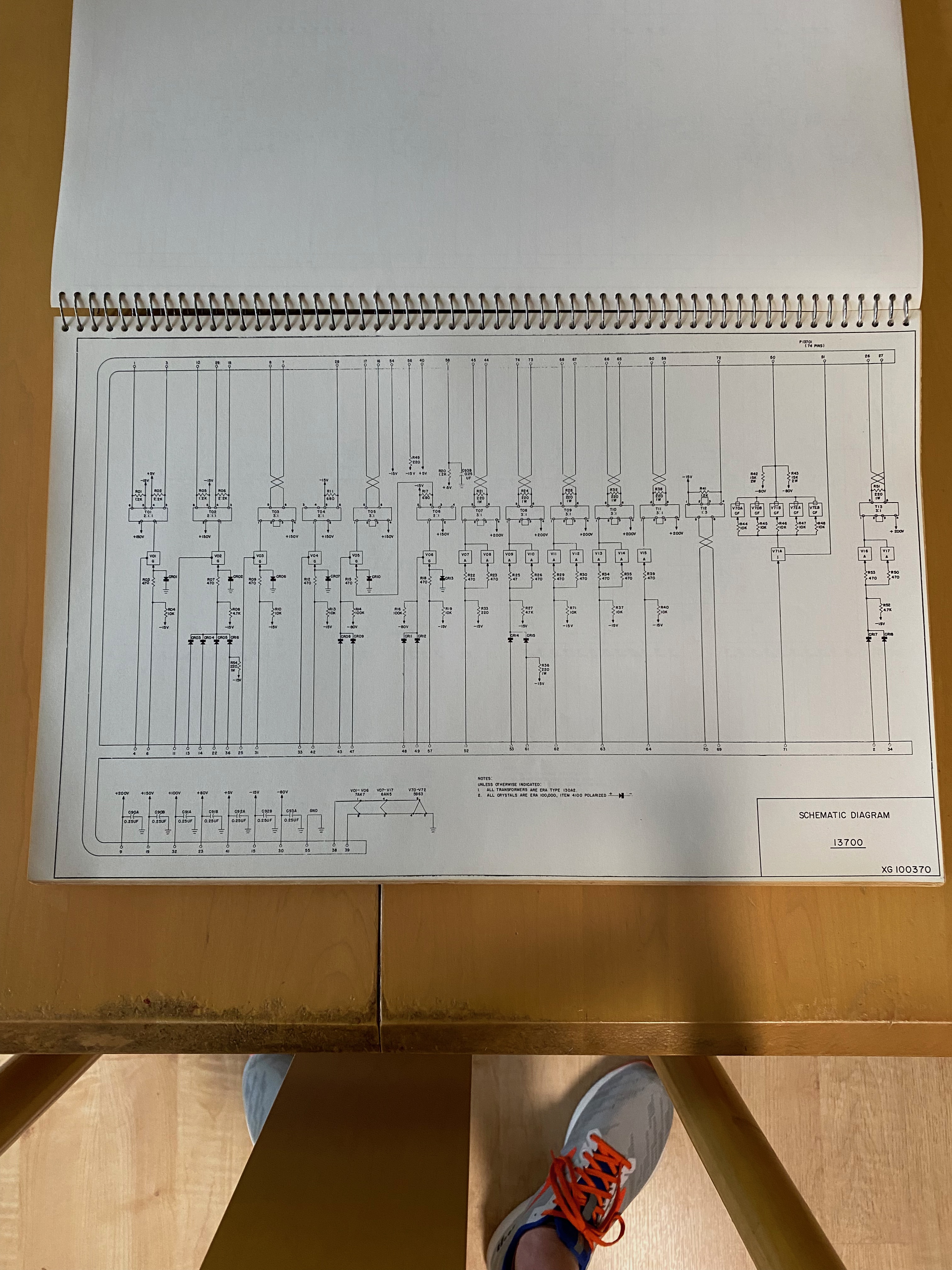

Information Technology (IT) Pioneers
Retirees and former employees of Unisys, Lockheed Martin, and their heritage companies
Commercial Computers, Chapter 59
1. Introduction
UNISYS is proud to claim that we possess the world's longest unbroken series of computers which started when ERA received government permission to market a commercial version of the then 'classified' Atlas computer. ERA had shipped the Atlas to the National Security Agency predecessor's cryptography department in October of 1950. It was fully operational in December 1950 - the world's first stored program computer in a customer's facility.
The UNIVAC/UNISYS
1100 series of computers began with
the 1101, a number coined
by the Atlas installation engineer, Jack Hill, because it
was developed under Task 13 - 13 in binary is 1101. This
product line series has evolved to today's 2000 series of
UNISYS business computers. Ron Q. Smith described
this history in the attached
slide series.
The two computer tree figures below show the five-decade relationship of this computer line. Information
about all of these computers is listed in a spread sheet file,
click here to read it.
The Sperry type No. file lists the configuration of most of
these systems,
GS3577.
The time relationships of the other UNIVAC computers developed in Philadelphia are shown on these trees as are the RCA and Varian computers which were bought out by UNIVAC. The early time relationships of the early defense industry computers which began with ERA are also shown.
2. Computer Tree, 1950 - 1963
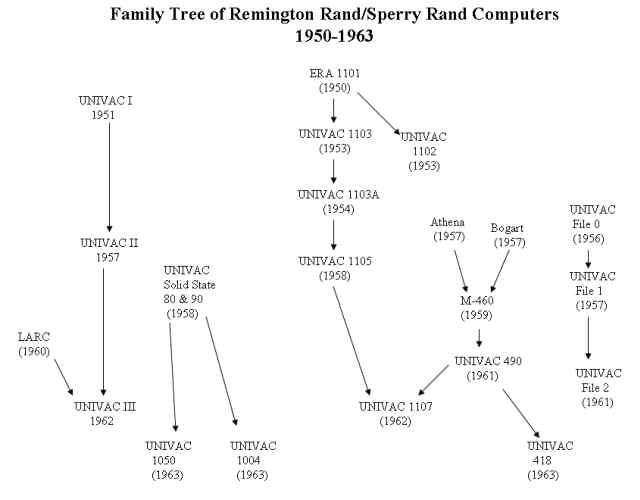
The left side of this Tree shows the computers that were developed in Blue Bell, PA.
The center and right side of the tree chart shows the computers developed in St. Paul, MN.
There was an 1104 computer that
used the 1103 logic design, reduced from 36 to 30 bits for the
Bomarc missile guidance system prototype. Although not
noted on this chart, the ERA 1101 was a commercial version of
the then classified ATLAS computer delivered and operating in
Washington DC in December of 1950.
A history tidbit is that UNIVAC I, S/N #16 was shipped to the St. Paul Minnehaha Ave. facility where it became the prototype for the UNIVAC II. Rollie Arndt was one of the engineers who designed and implemented a core memory to replace some of the Mercury tank memories of the UNIVAC I. Allan Reiter's web site page documented this information on page 16, now saved as on our site as http://vipclubmn.org/Articles/UNIVAC_I_Technical.pdf. Four boxes of Mr. Arndt's papers are catalogued at the Charles Babbage Institute.
Frank Ciesla provided us with these 1105 photos, via Paul Dickson;
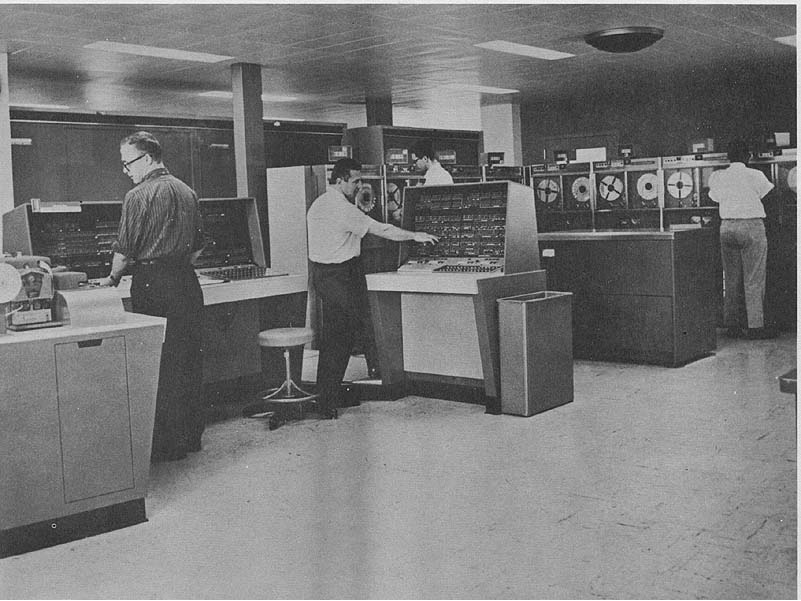
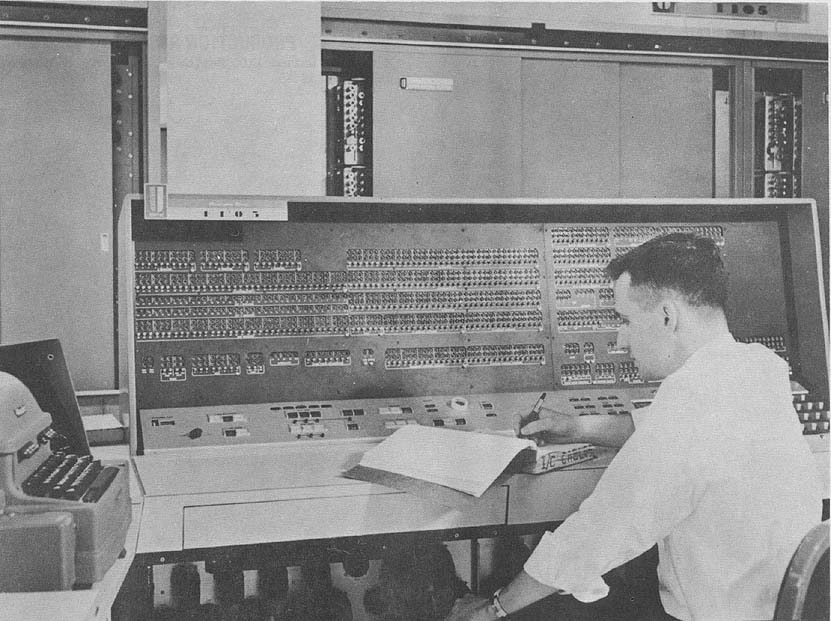
Frank Ciesla also provided us with a 1102 and a 1103A installed
pictures. Thanks to Paul Dickson for getting these to our Legacy
Anthology.
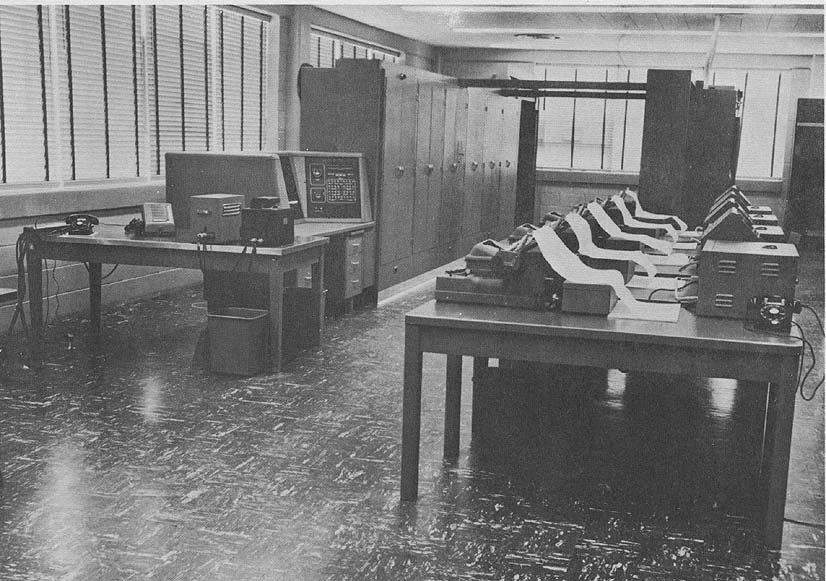
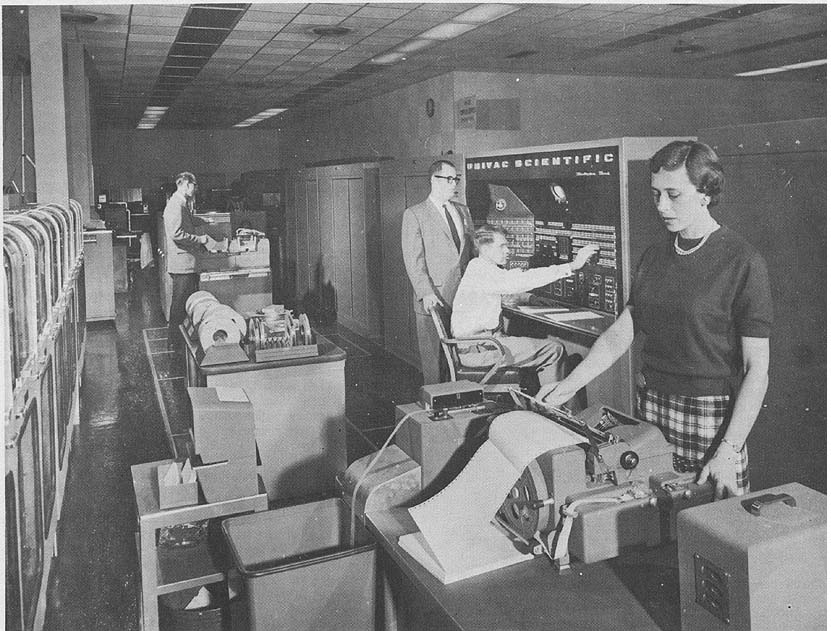
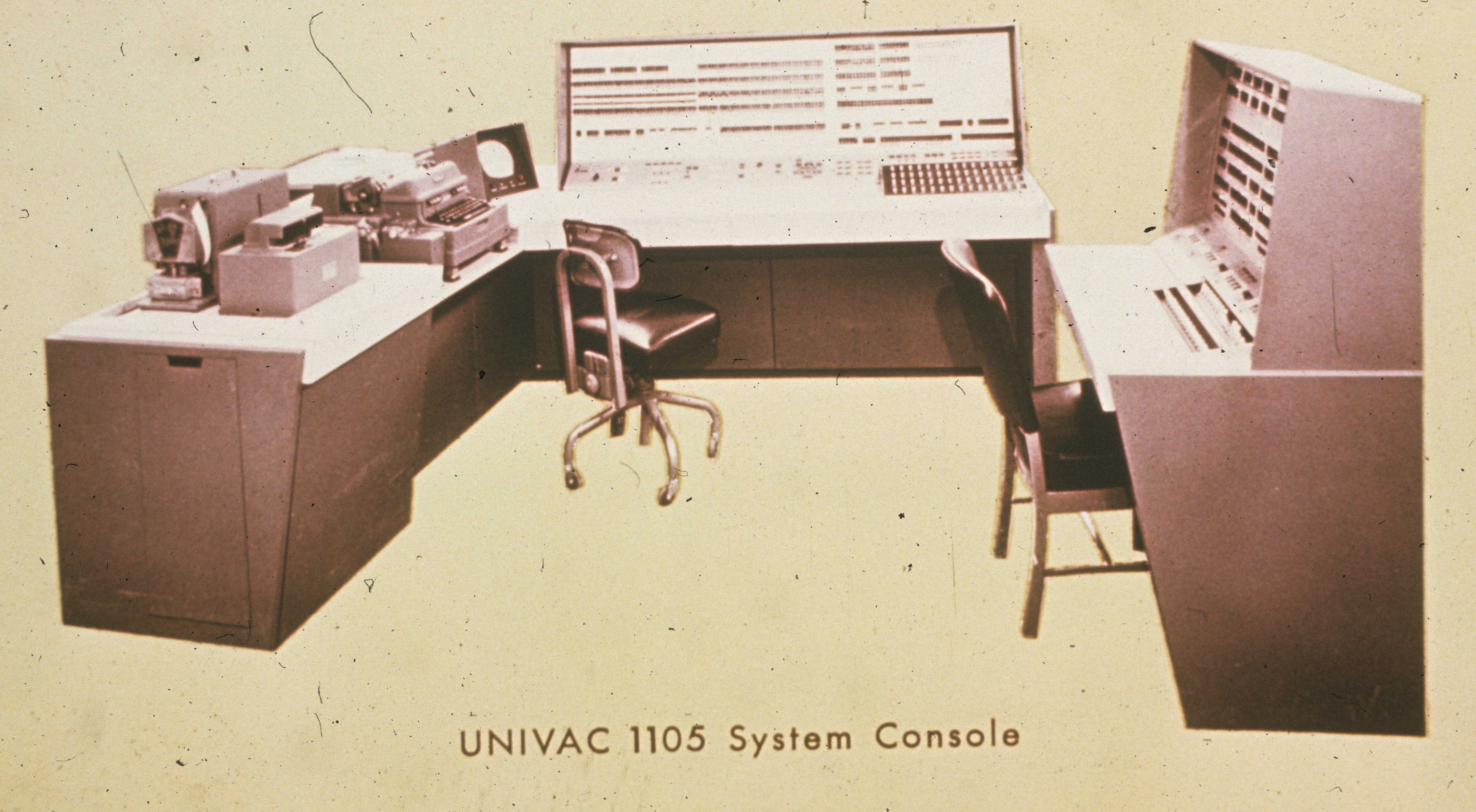 2.1 Early Computer References
2.1 Early Computer References
The bit-savers web site (http://bitsavers.informatik.uni-stuttgart.de/) has over 32,000 documents. We've copied and linked the documents associated with the early computer systems for research convenience. The bit-savers site also has a few pictures, i. e. the 1105 console shown here.
- BOGART Programmers Manual
- UNIVAC File Computer System Resume
- PX804 Bogart Computing System Theory of Operations
- PX824 Bogart Computing System Test Equipment
- SPTM4287 UNIVAC File Computer Operating Principles
- UNIVAC File-Computer System Specification
- Preliminary Description of the UNIVAC, for EMCC Personnel only.
- Programming for the UNIVAC Fac-Tronic System (has a good initial description of the UNIVAC I)
- PX18 1103A Programming (September 1956).pdf
UNIVAC File-Computer Programming Card (U-1717).PDF, scanned by Keith Myhre at the Lawshe Memorial Museum
 3.0 Computer Tree, 1962 - 1980
3.0 Computer Tree, 1962 - 1980
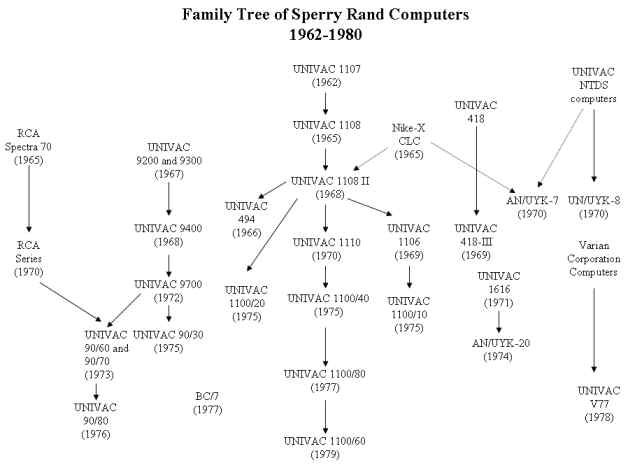
The ending point of the first tree (above
right) and the starting point of the second tree (below right) is the 1107
computer first delivered in 1962. A discussion about the 1108
II, the multi-processor son of the 1107 is in
another attached document.
The almost 2-decades of computers noted here reflect several things that took place during the era:
- At the left are the RCA computers that were merged into the Blue bell operations.
- At the far right middle are the Varian Corporation computers that were also merged into Blue Bell operations.
- At the right of the center '1965 UNIVAC 1108' is the Nike-X CLC. This developed the 'shared memory' by multiple processors technology that propagated into the 1108 II and the Navy's AN/UYK-7. The Nike-X design and prototype test was complete when the Strategic Arms Limitation Treaty curtailed production.
- The bottom right of the first chart shows the UNIVAC 418 that continues onto the second chart. Not shown thereon is that military variations of the 418 Instruction Set Architecture were the 1218 and 1219 series.
Frank Ciesla provided us with a test floor snapshot of the 1108. A few old time engineers may recognize that the 'engineer'
Frank is tweaking the intensity knob on an oscilloscope.

Frank also sent us two 1110 test floor photos: At the left
are Harry Corneliusen and Frank - Frank is also in the left
photo.
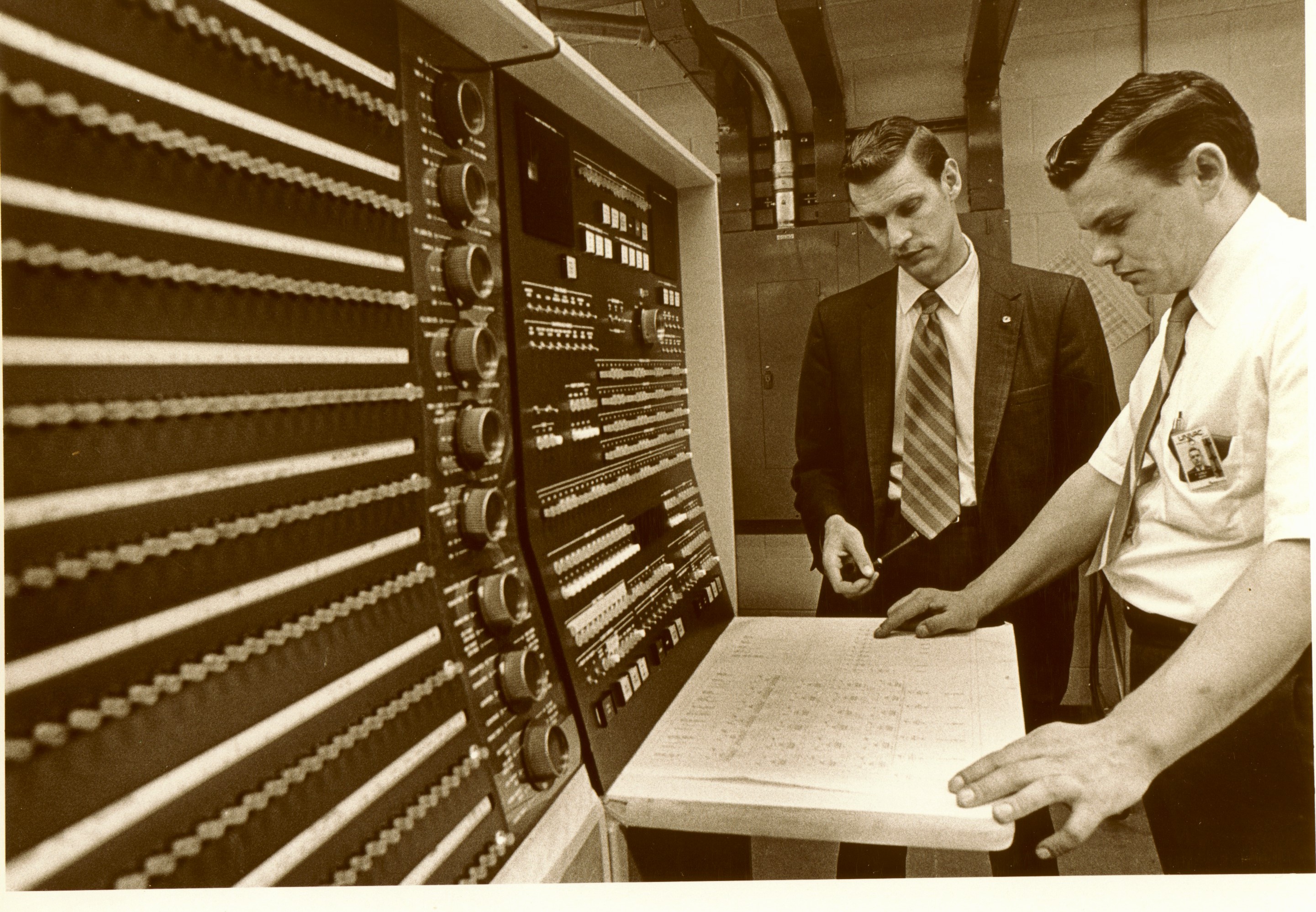
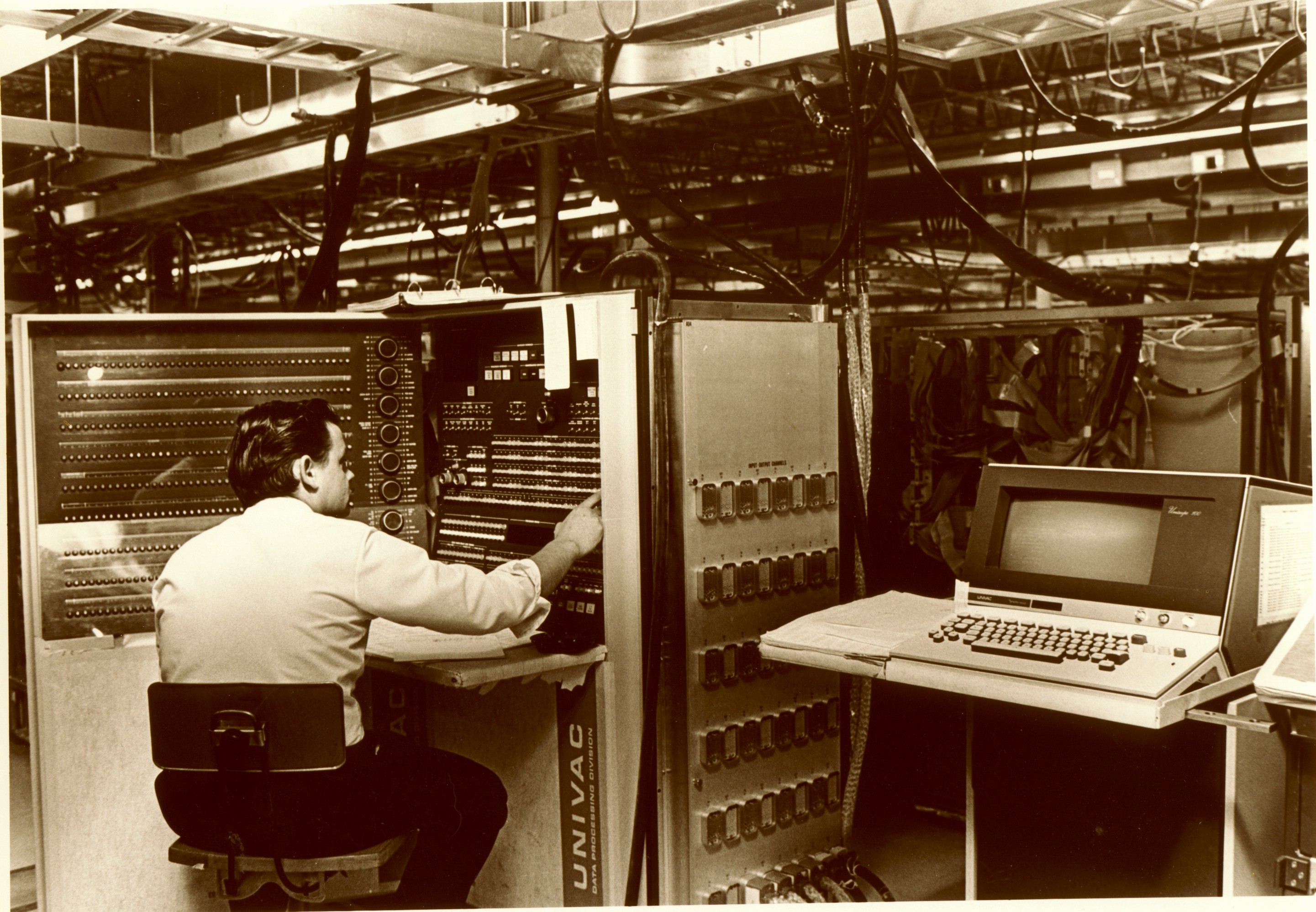
3.1. Design Standardization
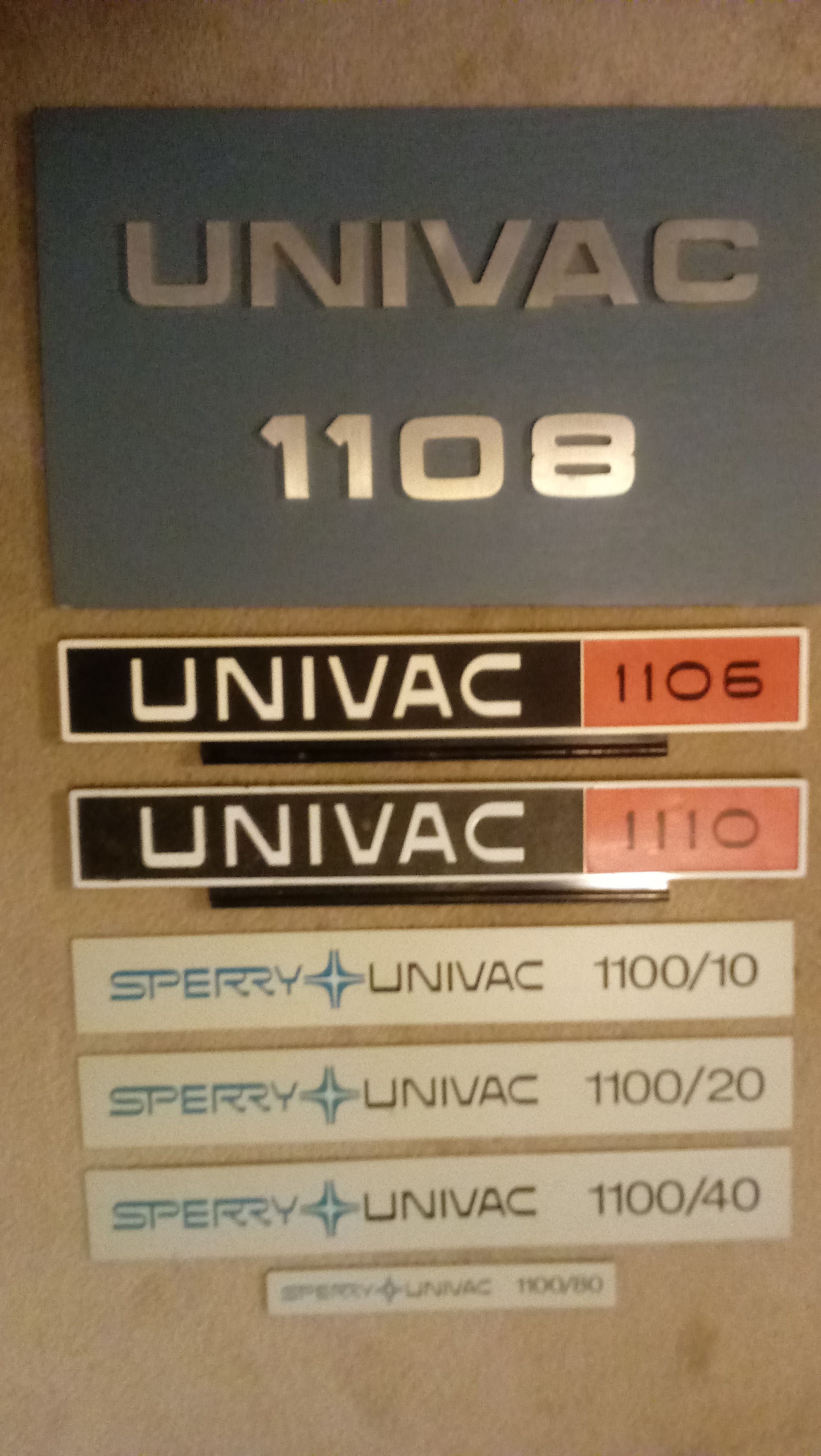 The 1100 series included the suite of peripherals as well as the single and multi-processor computer configurations.
The equipment names were normalized as illustrated by this set
from Paul Lindquist. He also provided us with the
standard colors booklet from
August 1971, U5329.
The 1100 series included the suite of peripherals as well as the single and multi-processor computer configurations.
The equipment names were normalized as illustrated by this set
from Paul Lindquist. He also provided us with the
standard colors booklet from
August 1971, U5329.
4. Repertoire Cards
Many people gave repertoire cards to the Legacy Committee. Keith Myhre scanned the cards before they were donated to the Charles Babbage Institute. The commercial computer cards are linked hereunder. There are copies of some of these cards at the Lawshe Memorial Museum.
- Sperry Univac 6135 Programmer's Reference Card
- Sperry Univac 6145 (Series 60) Assist Reference Card
- Sperry Univac Customer Engineers 6145 I/O Programming Reference Card
- Sperry Univac Series 70 Assembly Reference Card
- UNIVAC 494 Real-time System Reference Card-I
- UNIVAC 494 Real-time System Reference Card-II
- UNIVAC 1107 Instruction Repertoire
- UNIVAC 1108 COBOL Under Exec 8 Reference Card
- UNIVAC 1108 Code Card
- UNIVAC 9200/9300 Systems Reference Card
- UNIVAC 9200/9300 Card Punch Maintenance Card
- UNIVAC 9200/9300 Inter-Computer Control Unit Feature
- UNIVAC 9200/9300 Multiplexer Channel Maintenance Card
- UNIVAC 9200/9300 Systems Maintenance Card Instruction repertoire
- UNIVAC 9200/9300
Uniservo VIC Synchronizer

5.0 Early Computer Customer Lists
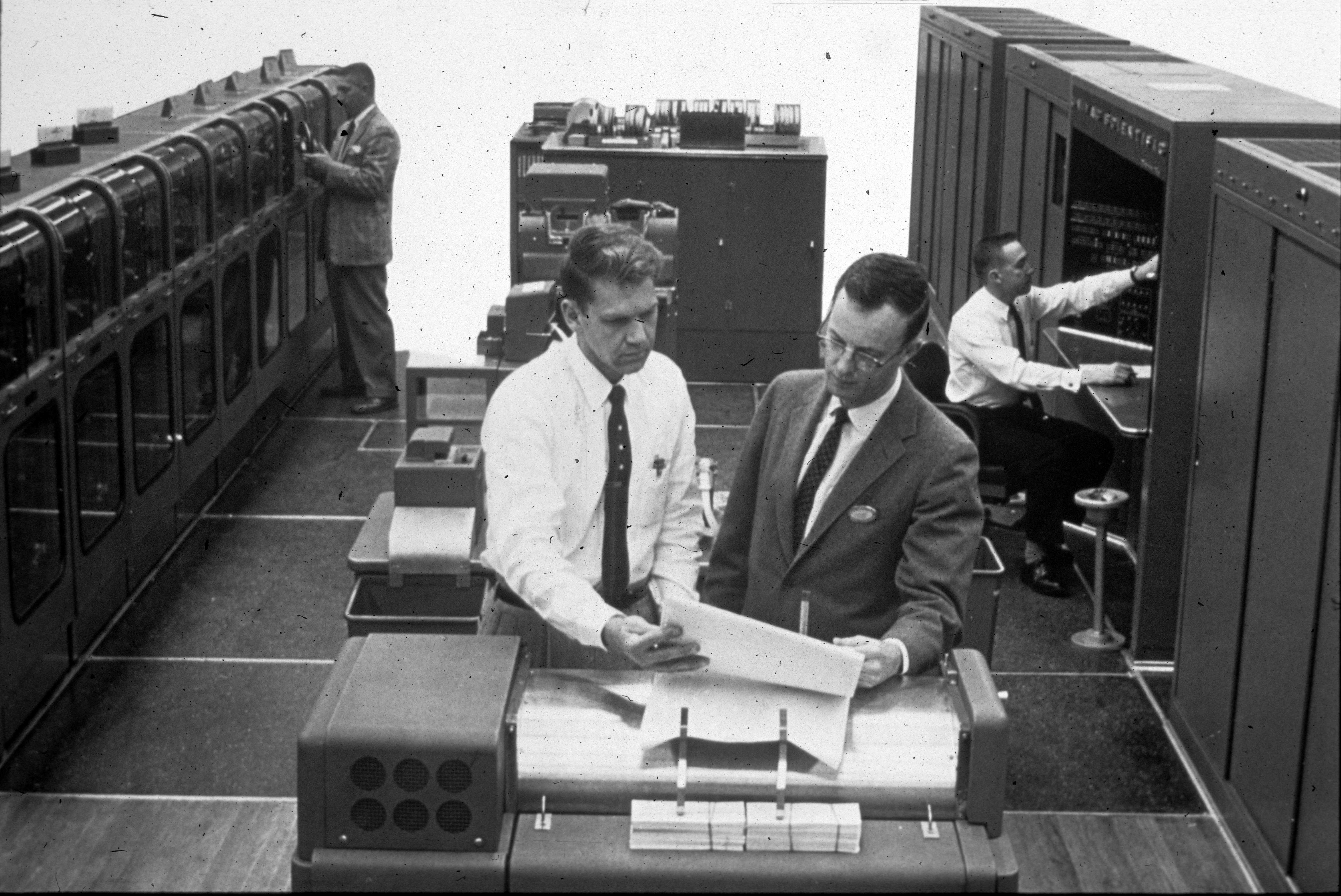 Our initial customers for these computer lines have been captured in a
document by Ron Q. Smith, some of his
information came from George Gray. At the right is a customer installation of an 1103, from
bit savers.
Our initial customers for these computer lines have been captured in a
document by Ron Q. Smith, some of his
information came from George Gray. At the right is a customer installation of an 1103, from
bit savers.
6. Technical Manuals
The bit-savers web site (http://bitsavers.informatik.uni-stuttgart.de/) has over 32,000 documents. We've copied and linked the documents associated with the computers in the two genealogy charts above for technology researchers ease of access. Note that the 1101, 1103, and defense computer series documents are linked from the various bit-length pages.
- ERA 1101 seminar about digital computers, a 1949 presentation.
- History and Evolution of 1100-2200 Mainframe Technology
- PX1790 Volume I, Unicoding the 1103A and 1105
- PX1790 Volume II, Unicoding the 1103A and 1105
- PX1790 Volume III, Unicoding the 1103A and 1105
- PX18 1103A Programming - September 1956
- PX19 1103A Contents of Registers - October 1956
- PX21 1103A Timing Sequences - October 1956.
- PX23 1103A System Maintenance, UNIVAC Scientific - February 1957
- PX44 1103A Instalation Requirements for Peripheral Equipment
- PX71871, ERA 1103 Computer System, Volume one
- PX71871, ERA 1103 Computer System, Volume two
- UNIVAC 1103A and 1105 Programming
- UNIVAC 1103A Floating Point Instruction Execution times
- UNIVAC 1103A Floating Point Instruction Registers
- UNIVAC 1103A Magnetic Tape System
- UNIVAC 1103A Preliminary Information, 1955
- U4465 UNIVAC 1004 III Magnetic Tape Systems
- U7265 Sperry Univac Series 1100 Sales Information Manual
- UP2575 UNIVAC 1107 Technical Bulletin
- UP2577 Rev. 1 UNIVAC 1107 Technical Bulletin Executive
- UP2577 UNIVAC 1107 Technical Bulletin
- UP2579 UNIVAC 1107 Technical Bulletin L Libraries
- UP2581 UNIVAC 1107 Technical Bulletin I/O Library
- UP3407 Rev 1 UNIVAC 1107 Uniservo IIIA
- UP4032R2 UNIVAC 494 Real-Time System
- UT2402 Rev 1 UNIVAC 490 Real-Time System
- UT2440 UNIVAC 1107 General Description
- UT2463 UNIVAC 1107 Technical bulletin Central Computer
- UT2560 UNIVAC 1107 Technical Bulletin Flying Head 880
- UT2561 UNIVAC 1107 Technical Bulletin Input-Output Instructions
- UT2562 UNIVAC 1107 Technical Bulletin Uniservo IIA
- UT2564 UNIVAC 1107 Technical Bulletin Punch Card Subsystem
- UT2574 UNIVAC 1107 Technical Bulletin Sleuth Assembly System
- UT3408 Rev 1 UNIVAC 1107 Technical Bulletin Uniservo IIIC Magnetic Tape
- CONUS 9100 (CONUS 24) Digital Computer Series Management Report. The CONUS (Continental U.S.) was a planned series of computers to succeed the 1004 units. Predecessor of the 9200/9300 systems.
- CONUS 24 (CONUS 9100) Digital Computer General Description
- 9140 Digital Computer Technical Description (Predecessor on paper to the 9200 & 9300 units)
- AUTODIN Message Concentrator Proposal using CONUS 24 Computer
In this Chapter
- Introduction [left]
- Computer Tree, 1950-1963 w/Bit Saver references documents
- Computer Tree, 1962-1980
- Early Computer Customer Lists
- Repertoire Cards
- Technical Manuals
Chapter 59 edited 7/13/2025.
John Alton's son donated the 1103A 'Scientific Computer' schematics to the Lawshe Memorial Museum. Photos and archiving by Keith Myhre.
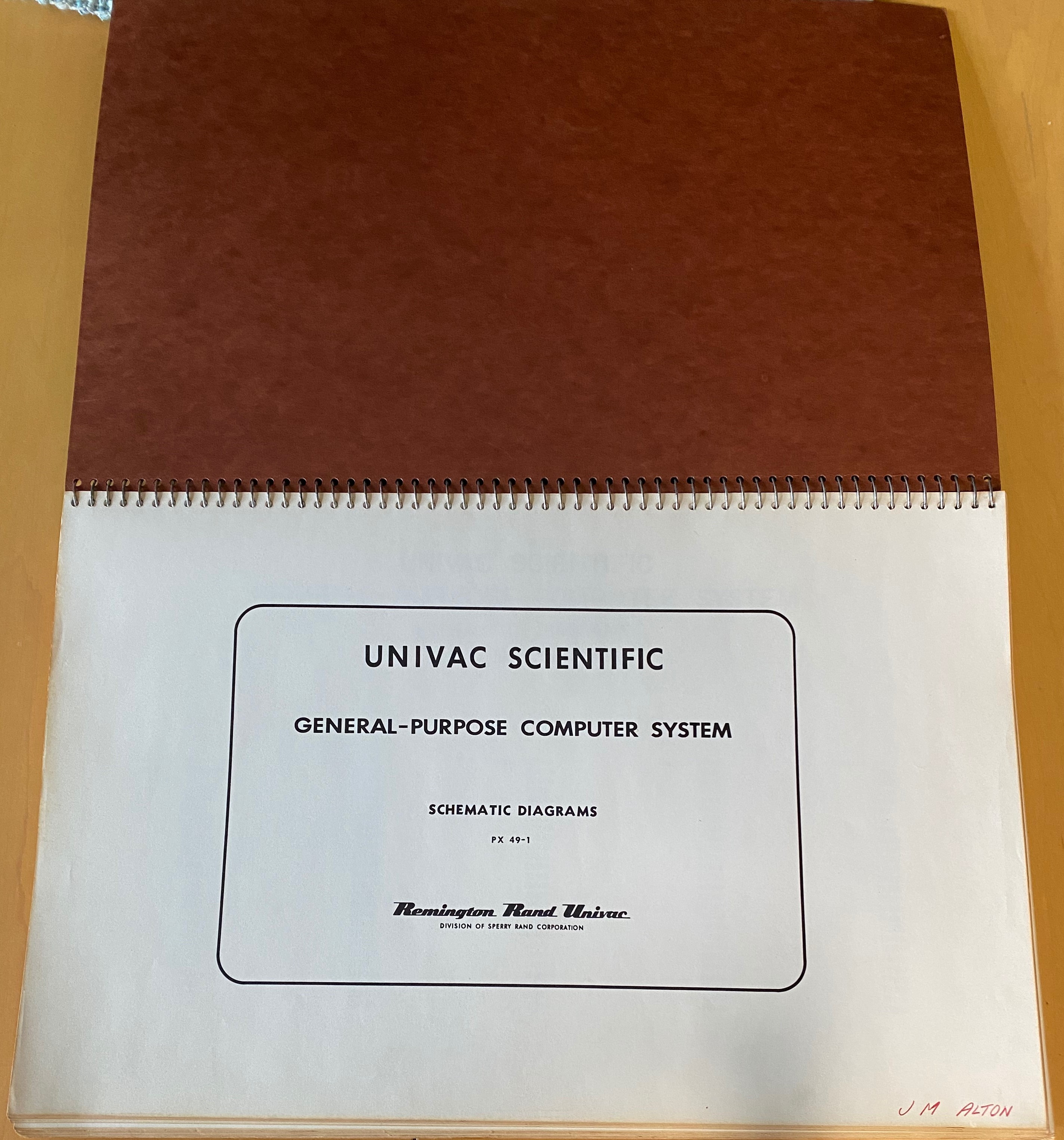
This is Remington Rand Univac publication PX 49-1; this page 137-01 shows 13 transformers,
23 vacuum tubes, 52 resistors, and 18 crystals all of which are linked to the system via 74 pins.
